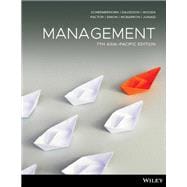Eldenburg's Management is an introductory text that focuses on presenting content in an easy to understand way that encourages students to think critically and draw connections between theory and practice. This new seventh edition has a strengthened focus on technology and features have been updated to help students further consolidate their knowledge.
This includes various forms of revision materials such as auto-graded knowledge-check questions and self-skill assessment. There is also a broad variety of concise case studies, including new ones with a strategic focus, which enable instructors to have thought-provoking and engaging tutorials. An exciting addition to the interactive e-text are the new ANZ videos that feature a diverse group of management thought-leaders who give insights and ‘tales from the front.’ This will provide supplementary content for lectures or serve as pre-work for a flipped classroom.








